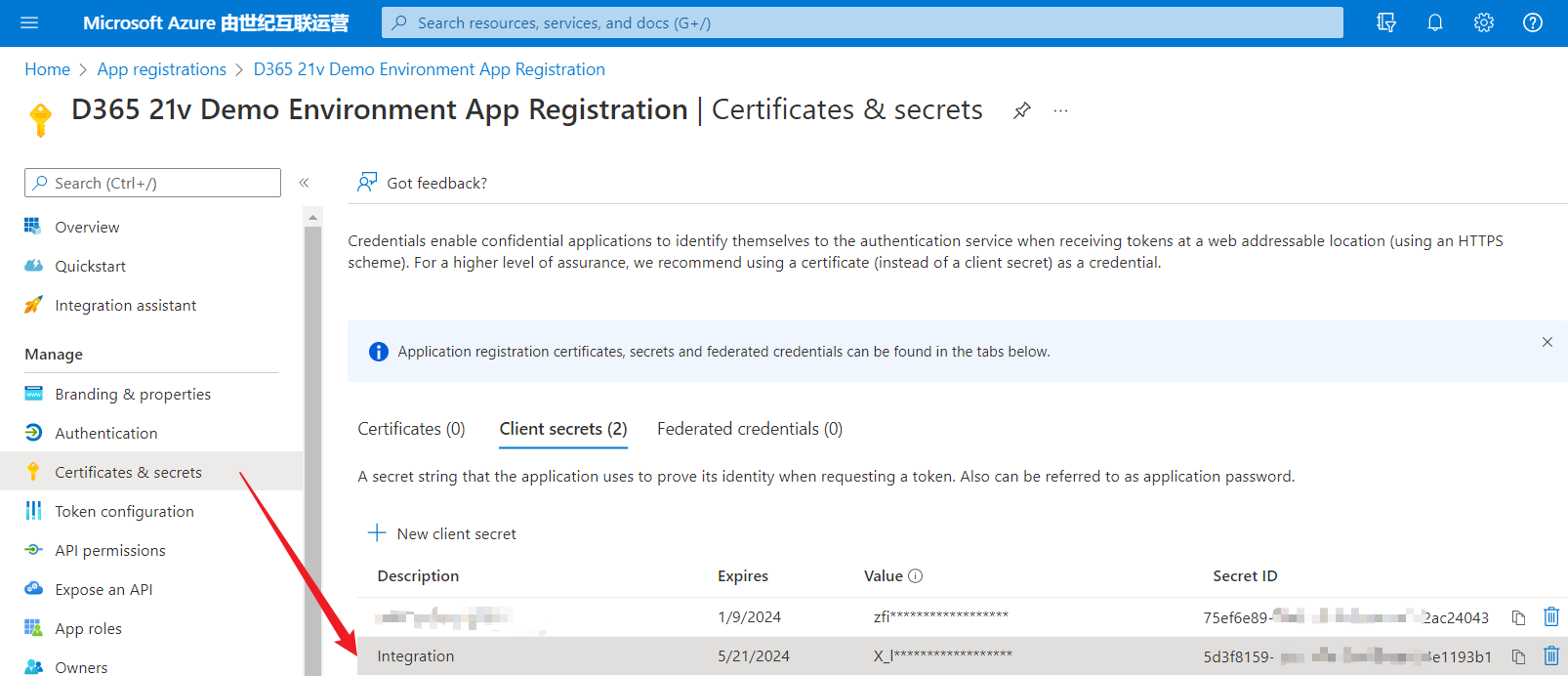Consume 21Vianet Dataverse Web API Using MSAL
All articles from this blog can ONLY be redistributed on an Attribution-NonCommercial-NoDerivs basis. Please credit the source, thank you.
Twitter:@kelvinshen
Blog:Kelvin Shen's Blog
Overall
The layers between a consumer client application and Dataverse Web API are:
- A client application.
- An Azure AD App Registration.
- A Dataverse Application user.
- The Dataverse Web API.
Client App
Please refer to this article for an app registration step-by-step guide.
Key Parameters
string dataverseInstanceUrl = "https://your-org-name.crm.dynamics.cn/"; //Specify the Dataverse instance to connect with.
var clientId = "84a7e91f-cf9a-46ce-9069-xxxx429dxxxx"; // Azure Application (client) ID
var clientSecret = "X_l7f2dvqy-h.FAkeaQ8r93W-RUt2xxXXX";
var authority = "https://login.partner.microsoftonline.cn/your-tenent-id/oauth2/v2.0/authorize";
Azure AD App Registration
OAuth authentication requires an AAD App registration, and it will contain setting values for the consumer application key parameters. I will highlight the location to get those values in the screenshots below.
ClientId

ClientSecret
One registered Azure Application can have many client secrets. You need to copy the secret value right after its creation because it will disappear afterwards.

Authority Endpoints

How to setup a Dataverse Application User?
- Log on to the Microsoft Power Platform Admin (D365 Admin) center as a system administrator.
- In the navigation pane, go to Environments and then select an environment from the list.
- On the Settings tab, go to Users “+ permissions”, and then select Application users. Then Click “+ New app user”.
- Click on the “Add an app” button and search for an previously registered Azure App
- Select a Business unit for the user
- Select Security roles for the user
How to Connect to Dataverse programmatically?
PublicClientApplicationBuilder Class
For interactive client apps, please use the PublicClientApplicationBuilder class to get security tokens
var authBuilder = PublicClientApplicationBuilder.Create(clientId)
.WithAuthority(AadAuthorityAudience.AzureAdMultipleOrgs)
.WithRedirectUri(redirectUri)
.Build();
var scope = resource + "/.default";
string[] scopes = { scope };
AuthenticationResult token =
authBuilder.AcquireTokenInteractive(scopes).ExecuteAsync().Result;
ConfidentialClientApplicationBuilder Class
For backend applications, where an OAuth prompt for user name and password is not an option, you should use the ConfidentialClientApplicationBuilder class.
Sample Code
static void Main()
{
// Specify the Dataverse environment name to connect with.
//string GlobalTenentResource = "https://<env-name>.<region>.dynamics.com";
//string ChinaTenentResource = "https://<env-name>.<region>.dynamics.cn";
string dataverseEnvironmentUrl = "https://your-env-name.crm.dynamics.cn/";
// For your custom apps, you will need to register them with Azure AD yourself.
var clientId = "84a7e91f-cf9a-46ce-9069-78cfxxxxxxxx"; // Application (client) ID
var clientSecret = "X_l7f2dvqy-h.XXxx0Q8r93W-RUt2xxXXX";
var authority = "https://login.partner.microsoftonline.cn/your-tenent-id/oauth2/v2.0/authorize";
#region Authentication
var clientApp = ConfidentialClientApplicationBuilder.Create(clientId)
.WithClientSecret(clientSecret)
.WithAuthority(new Uri(authority))
.Build();
var scope = dataverseEnvironmentUrl + "/.default";
string[] scopes = { scope };
AuthenticationResult token
= clientApp.AcquireTokenForClient(scopes).ExecuteAsync().GetAwaiter().GetResult();
#endregion Authentication
#region Client configuration
var client = new HttpClient
{
BaseAddress = new Uri(dataverseEnvironmentUrl + "/api/data/v9.2/"),
Timeout = new TimeSpan(0, 2, 0) // Standard two minute timeout on web service calls.
};
// Default headers for each Web API call.
HttpRequestHeaders headers = client.DefaultRequestHeaders;
headers.Authorization = new AuthenticationHeaderValue("Bearer", token.AccessToken);
headers.Add("OData-MaxVersion", "4.0");
headers.Add("OData-Version", "4.0");
headers.Accept.Add(
new MediaTypeWithQualityHeaderValue("application/json"));
#endregion Client configuration
#region Web API call
// Invoke the Web API 'WhoAmI' unbound function.
var response = client.GetAsync("WhoAmI").Result;
if (response.IsSuccessStatusCode)
{
// Parse the JSON formatted service response (WhoAmIResponse) to obtain the user ID value.
Guid userId = new Guid();
String jsonContent = response.Content.ReadAsStringAsync().Result;
using (JsonDocument doc = JsonDocument.Parse(jsonContent))
{
JsonElement root = doc.RootElement;
JsonElement userIdElement = root.GetProperty("UserId");
userId = userIdElement.GetGuid();
}
Console.WriteLine("Your user ID is {0}", userId.ToString());
}
else
{
Console.WriteLine("Web API call failed");
Console.WriteLine("Reason: " + response.ReasonPhrase);
}
#endregion Web API call
// Pause program execution by waiting for a key press.
Console.ReadKey();
}
}
References
- https://nishantrana.me/2020/12/17/consume-dynamics-365-web-api-using-msal-net/
- https://docs.microsoft.com/en-gb/azure/active-directory/develop/msal-net-initializing-client-applications
- https://www.nuget.org/packages/Microsoft.Identity.Client/